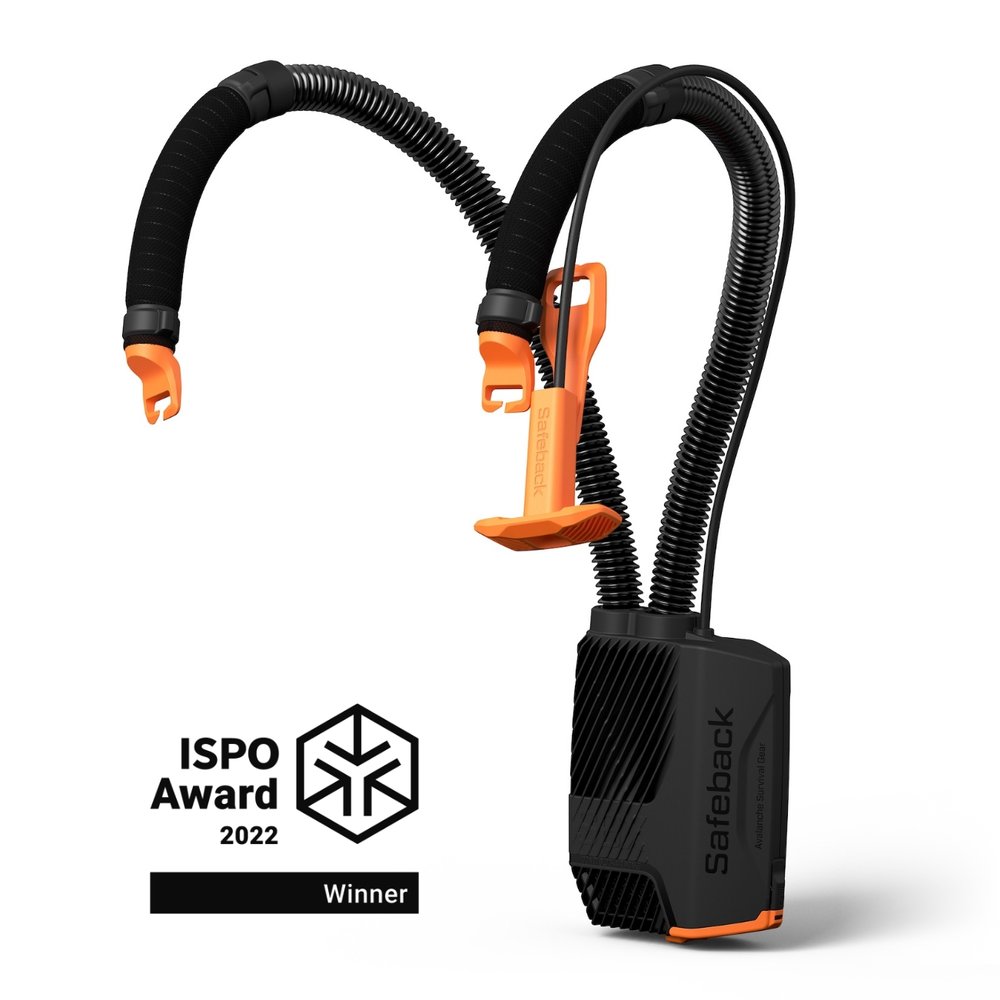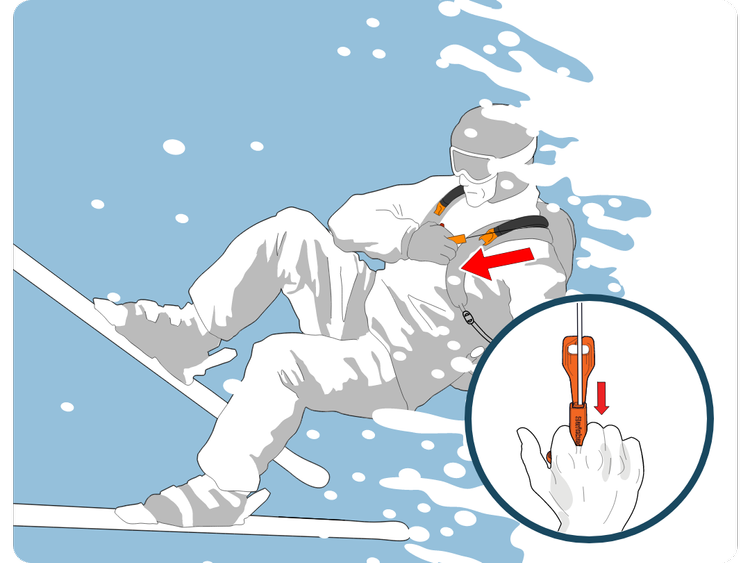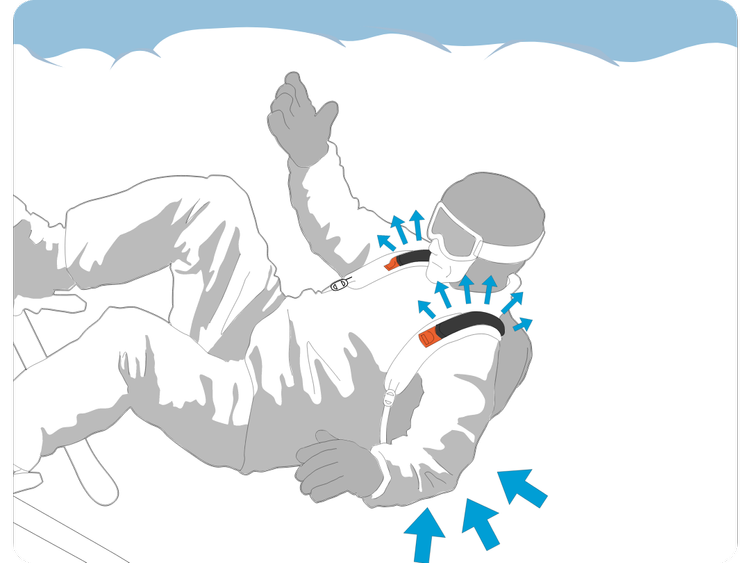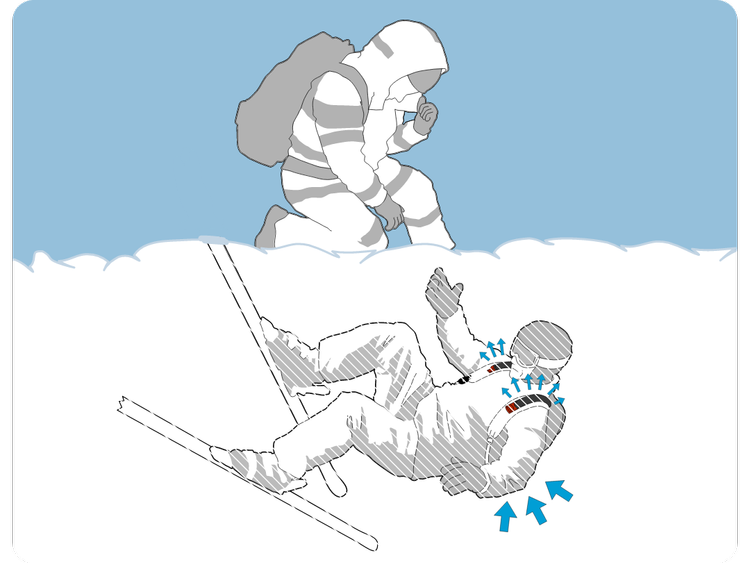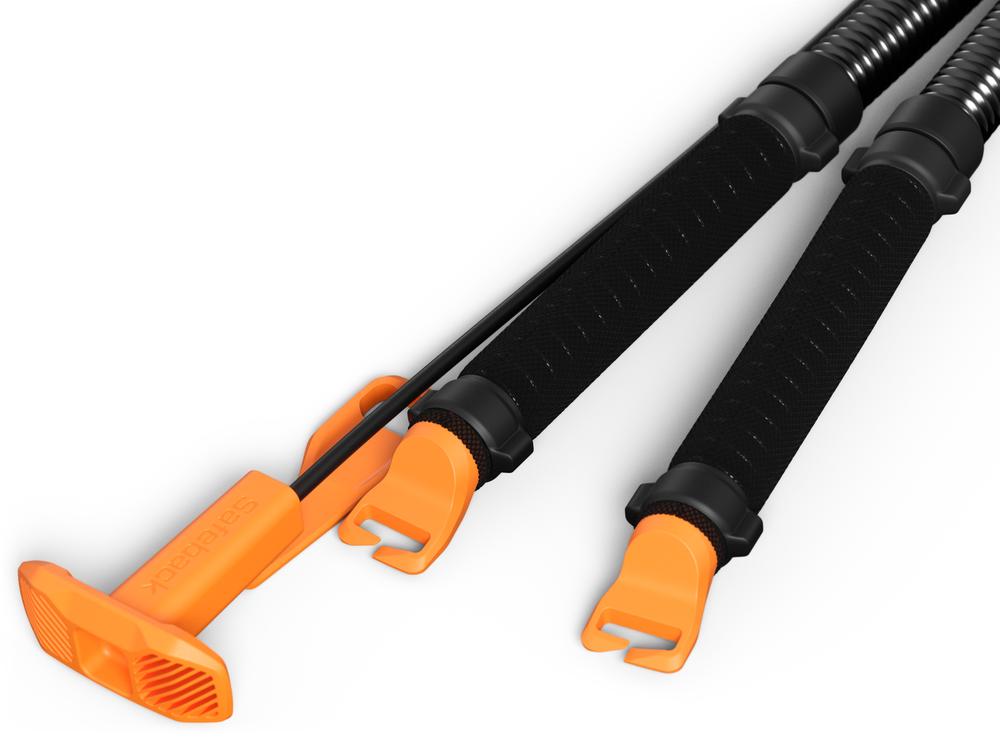The Safeback SBX Avalanche Survival System: A New Way to Survive
January 6, 2023 | By Will BrendzaThe Safeback SBX avalanche survival system hasn’t even officially hit the market, and it’s already won an ISPO innovation award and is up for another innovation award at the Outdoor Retailer Snow Show. We got our hands on the system to take a close first look at the new technology.
When a person is buried in an avalanche, a countdown starts. They only have 10 minutes before they start to run out of air. A study from Canada found that after 35 minutes, they only have a 10% chance of survival, with almost certain brain damage.
It’s why you’re supposed to cup your hands over your nose and mouth if you find yourself in that terrifying situation. It creates a small pocket of air that you can breathe from. And with any luck, that could extend your chances of survival — and when you’re under snow, every second counts.
Safeback is taking that concept to the next level. After years of innovation and design, Safeback has developed a system that can extend a buried person’s survival time under snow up to 90 minutes. It’s a system that essentially turns your entire backpack into an air pocket to breathe from.
“Five years of advanced research and development ended up with an elegant and simple solution,” William Sherman, the CMO of Safeback, told GearJunkie. “[It’s] an air pump in your backpack that is supplying your breathable air.”
We connected with Sherman to get our hands on the Safeback SBX system and see the new technology for ourselves. And from what we learned, this could be a seriously disruptive device in the world of backcountry skiing.
It’s not hyperbole to say that this system could save hundreds, maybe even thousands, of lives.
Hands-on With Safeback SBX
 The Safeback SBX system in its entirety; (photo/Will Brendza)
The Safeback SBX system in its entirety; (photo/Will Brendza)GearJunkie covered Safeback’s 2022 ISPO innovation award and its recent partnerships with Db and Bergans. It’s linking up with those brands to design backpacks and vests that incorporate the Safeback SBX system.
But this was the first time we’d interacted with the device in person. And when Sherman opened the box and pulled the Safeback SBX out, we were immediately surprised by its size and weight. It’s small. And in total, with the batteries, it weighs just 513 grams, or 18 ounces.
Two hoses extend from the battery pack and air intake. Those will run up through the shoulder straps of one of Bergens’ bags or Db’s vests. The intake remains in the bag on the wearer’s back. It pumps air in from the surrounding snow to your backpack, up the tubes, and out of the vents on the shoulder straps.
“When the system was being designed, a group of medical researchers in Norway conducted an experiment with 20 live burial victims who were buried twice: once with no air, and once with 2L of supplemental air per minute,” Sherman explained. That study showed significant improvements in survivability of snow burial.
“So the engineers used 2L per minute as the minimum requirement for air supply in situations where your head is as far away as 10in. from an air outlet,” he continued. “If your mouth and nose are closer to the outlet, then the effect of our system improves drastically.”
 The Energizer Ultimate Lithium batteries were chosen for their longevity and cold resistance; (photo/Will Brendza)
The Energizer Ultimate Lithium batteries were chosen for their longevity and cold resistance; (photo/Will Brendza)Safeback SBX Battery Life
But it isn’t enough to pump air from the snow around a user’s body to their face so they can breathe it. The system also had to be able to function for as long as possible.That’s why Safeback SBX uses Energizer Ultimate Lithium batteries. Sherman explained that these specific batteries operate very well in cold temperatures. He said Safeback tested several other lithium batteries, but the Energizer’s lasted the longest. And that’s really what they wanted.
“At -22 degrees Fahrenheit, we can deliver air for 90 minutes,” Sherman said. “So at a regular temperature like 15 degrees, we’re delivering [air] for 2 hours. And then at 30 [degrees], it’s 160 minutes. So it’s a huge, huge amount of time as a result of these batteries.”
Despite having longer runtimes at warmer temps, Safeback only promises 90 minutes of breath time with this device, Sherman adds.
 The green light indicates the system check is in progress; (photo/Will Brendza)
The green light indicates the system check is in progress; (photo/Will Brendza)When you turn the Safeback SBX on, it always runs a system check. You’ll hear the fans humming, and a blinking green light flashes on top. The system starts checking its voltage, checking the software and the electronics, and making sure the airways aren’t blocked. You can manually run the same test by simply holding down the device’s button, Sherman demonstrated.
Then, you’re ready to hit the backcountry slopes.
 The Db vest was designed specifically for the Safeback SBX system; (photo/Will Brendza)
The Db vest was designed specifically for the Safeback SBX system; (photo/Will Brendza)The Db Vest and Sage Kotsenburg
While Safeback partnered with both Bergan and Db to design bags and vests that accommodate the Safeback SBX system, only Db’s vest will be available in the U.S. It’s a cool piece of backcountry gear, with 8 L of storage in the back and two monster front panel pockets.The vest has a compartment for the Safeback SBX. And the shoulder straps have a mesh top so that the hoses can easily pump air out of them. An orange activation handle extends from the left shoulder strap, and when pulled, the Safeback SBX system turns on.
 Safebacl SBX activation trigger in the Db vest; (photo/Will Brendza)
Safebacl SBX activation trigger in the Db vest; (photo/Will Brendza)Sherman says they future-proofed those activation handles, so they could easily be integrated with an avalanche airbag. Then, you’d only have to pull one cord, and two avalanche rescue systems would engage. Sherman wouldn’t divulge details, but he did say that Safeback is already in discussions with airbag brands who want to join forces.
“It [will be] the world’s most advanced avalanche backpack,” he said. “That’s totally coming.”
Until then, the Db vest will have to suffice for U.S. backcountry skiers. That’s okay because together, this vest and the integrated Safeback SBX system are making a leap forward in avalanche rescue innovation on their own. Even without an airbag, it’s still safe to call Db’s Safeback avi vest one of the most advanced avalanche backpacks ever designed.
 The compartment in the Db vest that houses the Safeback SBX; (photo/Will Brendza)
The compartment in the Db vest that houses the Safeback SBX; (photo/Will Brendza)It’s why Sage Kotsenburg has signed on with the project. He’ll be wearing the Db vest this season — he trusts the system. And if there’s anything that Safeback SBX wants to establish right out of the gate, it’s trust.
“We’re going to be doing all we can to get this in the hands of the right people this season so that there is a base level of trust for the work that we put into the products up to now,” said Sherman. “Trust is the most important thing in this product.”
 The air vents and activation handle of the Safeback system; (photo/Will Brendza)
The air vents and activation handle of the Safeback system; (photo/Will Brendza)A Different Promise From Avi Airbags
The idea behind an avi airbag is simple and effective — but far from perfect. You pull an activation handle on your backpack, and a big balloon erupts out of it. Because snow is water, and air floats in water, the hope is that the airbag makes a skier or rider float to the top instead of getting buried under snow.Airbag systems like ABS have been around since the ’90s. And they’ve saved countless lives. According to a 2014 study published in the journal Resuscitation, the probability of being critically buried is 47% without an airbag and decreased to 20% with an airbag.
But the folks at Safeback are quick to distinguish a notable difference in what they promise users. Avi bags offer confidence that the user won’t get buried, won’t have to be saved, and won’t really even need their beacon because, hopefully, they won’t go under. That sense of security sometimes encourages people to do overly dangerous things.
Safeback SBX, by contrast, is in alignment with keeping your beacon on “send” mode always. It can’t promise to stop you from being buried (and realistically, neither can an airbag system). But it can provide 90 minutes of breathing time. And in most cases, that will extend survival exponentially.
 (Photo/Will Brendza)
(Photo/Will Brendza)Safeback SBX: A 2023/24 Product
Unfortunately for backcountry skiers and riders, Sherman says the pre-sale for Safeback’s Db vest won’t be until the spring of 2023 (March or April). So people won’t really get to try the system out until next season.Both the Safeback SBX system and the Safeback vest are up for innovation awards at the Outdoor Retailer show next week. And Sherman has his fingers crossed that they could also win Product of the Year.
Regardless of awards, Safeback SBX has a lot in the works. It’s already looking to expand, putting its survival system into more bags made by more brands. The brand is also engaging in a lot of research that he wouldn’t go on record with.
There’s a reason why the Safeback SBX system is already making waves and hasn’t even hit the market yet. This technology has a lot of potential to save people’s lives. And with the exploding popularity of backcountry skiing, devices like this are going to be increasingly important.

The Safeback SBX Avalanche Survival System: A New Way to Survive
GearJunkie got its hands on the Safeback SBX avalanche survival system to take a close first look at the disruptive new technology.



